History of Chicago
Brief history of Chicago summarized
We review the brief history of Chicago summarized.
Chicago’s founding
The history of Chicago begins in the year 1673. In that year two Frenchmen, Jacques Marquette and Louis Joliet, arrived in the area. (The name Chicago is derived from a Native American word of uncertain meaning, checagou.)
However, the French did not settle in the area. The first non-Indigenous person to make their home in the area was an African American from the Caribbean named Jean Baptiste Point du Sable who built a house there in 1779.
Then, in 1803, the American government built a fort called Fort Dearborn. The fort was destroyed during the War of 1812, but was rebuilt in 1816. A small settlement grew up next to the fort.
19th century Chicago
In the 1830s, Chicago grew rapidly. Chicago was incorporated as a city in 1833, although it only had a population of a few hundred. However, Chicago multiplied and by 1837 had a population of 4,000. In that year Chicago became a city.
Chicago boomed during the 1840s and by 1850 had a population of 30,000. In the following decade it grew at an astonishing rate. By 1860 the population of Chicago was 109,000.
Chicago also became the transportation hub of the United States. The Illinois and Michigan Canal opened in 1848 and by 1860 15 railroad companies had a terminus in Chicago. The city became famous for meatpacking and in 1865 the Union Stock Yards opened.
By 1870 Chicago’s population had grown to about 300,000. However, Chicago was devastated by fire in 1871. The Chicago Fire started on the night of October 8 in a barn. According to legend, it was caused by a cow knocking over a lamp.
In any case, the fire spread through downtown Chicago, where the houses were made of wood, and burned until October 10. About 100,000 people, about a third of the population were left homeless and about 300 people died. Fortunately, the Chicago industry survived.
Chicago was soon rebuilt and in the late 19th century continued to grow rapidly. In 1880 the population of Chicago reached 503,000 inhabitants. It continued to increase rapidly. In 1900 the population was almost 1.7 million inhabitants.
However, in 1886 came the Haymarket Massacre. In May 1886 there was a strike in Chicago in support of an 8-hour day. On the night of May 4, a rally was held in Haymarket Square.
The police ordered the protesters to leave and someone threw a pipe bomb into their ranks. The police responded by shooting into the crowd. Then the anarchists were rounded up and finally 4 were hanged.
In July 1894, during a railroad strike, President Grover Cleveland sent troops to Chicago.
In the closing years of the 19th century, Chicago continued to grow at an astonishing rate. Meanwhile, the world’s first skyscraper, the Home Insurance Building, was built in 1884.
Other famous late 19th-century buildings in Chicago include the Rookery, built in 1888 (its lobby was redesigned by Frank Lloyd Wright in 1905), and the Fine Arts Building, built in 1885. The Chicago World’s Fair was held in 1893. It was held in Jackson Park.
Chicago in the 20th century
In 1903 the city of Chicago suffered a disaster when a fire broke out in the Iroquois Theater and almost 600 people died. The Iroquois Theater was demolished in 1925 and was replaced by the Oriental Theater.
In the early 20th century, Chicago’s population continued to grow. By 1920 it had reached 2.7 million. In 1930 the population of Chicago was 3,376,000.
In 1927, the Chicago Municipal Airport opened. (now called Midway Airport). The John G Shedd Aquarium opened in 1930. The Alder Planetarium also opened in 1930. Then in 1933, Chicago hosted the Century of Progress World’s Fair.
The Museum of Science and Industry in Chicago opened its doors in that year. In 1942 Enrico Fermi carried out the first controlled nuclear reaction at the University of Chicago.
Meanwhile, a notorious event in Chicago history was the Valentine’s Day Massacre of 1929. Al Capone planned to kill his enemy, a man named George Bugs Moran. So at 10:30 a.m. on February 14, Valentine’s Day, a car pulled into a garage on the north side.
The car was the type used by detectives and had police insignia painted on it. Inside were two men dressed as policemen. There were also two men in plain clothes posing as plainclothes detectives in the car.
His car pulled up outside the garage and the two men posing as detectives got out. At that moment Bugs Moran and his two bodyguards approached. Seeing the two fake policemen, they thought it was a police raid and left. So Bugs Moran survived.
However, there were seven men inside the garage and the fake cops made them line up against a wall and face her. The two men in civilian clothes entered with machine guns and sprayed them with bullets. The fake cops produced shotguns and killed any man who showed signs of life. The assassins left.
In 1950 Chicago’s population peaked at 3.6 million. However, at the end of the 20th century the population of the city gradually decreased.
In 1955 Democrat Richard J. Daley became mayor of Chicago. He was mayor until 1976. In 1979 Jane Byrne became the first female mayor of Chicago and in 1983 Harold Washington became the first African-American mayor. However, in 1990 Chicago ceased to be the second largest city in the United States.
Meanwhile, in 1968 the first Special Olympics were held in Chicago. Then, in 1973, the Willis Tower opened. Navy Pier opened in 1995.
Chicago today
In the 21st century Chicago continues to flourish. Millennium Park opened in 2004 and the Spertus Museum in 2007. Trump International Hotel and Tower was built in 2009. Meanwhile, the Cloud Gate sculpture was created in 2006. In 2016 Chicago’s population was 2.7 million.
Share the brief history of Chicago in a nutshell.

